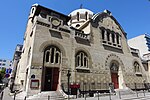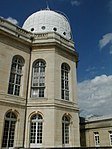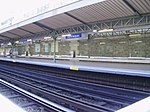Place Denfert-Rochereau

Place Denfert-Rochereau, previously known as Place d'Enfer, is a public square located in the 14th arrondissement of Paris, France, in the Montparnasse district, at the intersection of the boulevards Raspail, Arago, and Saint-Jacques, and the avenues René Coty, Général Leclerc, and Denfert-Rochereau, as well as the streets Froidevaux, Victor-Considérant and de Grancey. It is one of the largest and most important squares on the left bank of the Seine. The square is named after Pierre Denfert-Rochereau, the French commander who organized the defense at the siege of Belfort during the Franco-Prussian War (1870–1871). It is dominated by the Lion of Belfort statue (a smaller version of the original in the town of Belfort) by Frédéric Bartholdi. The square is the location of the Paris Catacombs museum. It is frequently the place where demonstrations and protest marches in Paris either start or end. The square is also the place depicted on the backdrop at the beginning of the third act of La Bohème by Puccini.
Excerpt from the Wikipedia article Place Denfert-Rochereau (License: CC BY-SA 3.0, Authors, Images).Place Denfert-Rochereau
Avenue du Colonel Henri Rol Tanguy, Paris Paris (Paris)
Geographical coordinates (GPS) Address Nearby Places Show on map
Geographical coordinates (GPS)
| Latitude | Longitude |
|---|---|
| N 48.83435 ° | E 2.3323944444444 ° |
Address
Denfert-Rochereau
Avenue du Colonel Henri Rol Tanguy
75014 Paris, Paris (Paris)
Ile-de-France, France
Open on Google Maps










